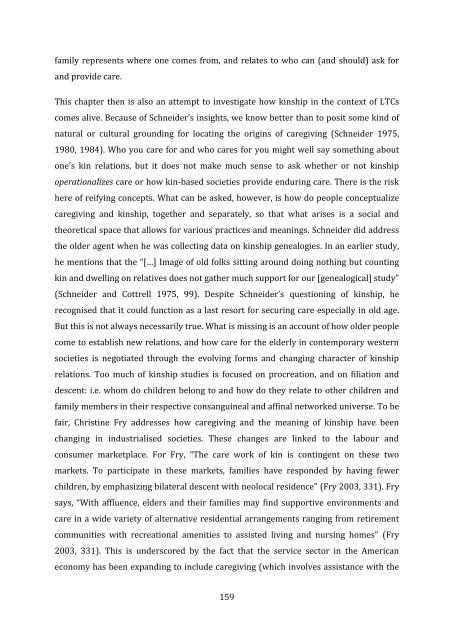Philip Y. Kao PhD thesis - Research@StAndrews:FullText
Philip Y. Kao PhD thesis - Research@StAndrews:FullText
Philip Y. Kao PhD thesis - Research@StAndrews:FullText
You also want an ePaper? Increase the reach of your titles
YUMPU automatically turns print PDFs into web optimized ePapers that Google loves.
family represents where one comes from, and relates to who can (and should) ask for<br />
and provide care.<br />
This chapter then is also an attempt to investigate how kinship in the context of LTCs<br />
comes alive. Because of Schneider’s insights, we know better than to posit some kind of<br />
natural or cultural grounding for locating the origins of caregiving (Schneider 1975,<br />
1980, 1984). Who you care for and who cares for you might well say something about<br />
one’s kin relations, but it does not make much sense to ask whether or not kinship<br />
operationalizes care or how kin-based societies provide enduring care. There is the risk<br />
here of reifying concepts. What can be asked, however, is how do people conceptualize<br />
caregiving and kinship, together and separately, so that what arises is a social and<br />
theoretical space that allows for various practices and meanings. Schneider did address<br />
the older agent when he was collecting data on kinship genealogies. In an earlier study,<br />
he mentions that the “[…] Image of old folks sitting around doing nothing but counting<br />
kin and dwelling on relatives does not gather much support for our [genealogical] study”<br />
(Schneider and Cottrell 1975, 99). Despite Schneider’s questioning of kinship, he<br />
recognised that it could function as a last resort for securing care especially in old age.<br />
But this is not always necessarily true. What is missing is an account of how older people<br />
come to establish new relations, and how care for the elderly in contemporary western<br />
societies is negotiated through the evolving forms and changing character of kinship<br />
relations. Too much of kinship studies is focused on procreation, and on filiation and<br />
descent: i.e. whom do children belong to and how do they relate to other children and<br />
family members in their respective consanguineal and affinal networked universe. To be<br />
fair, Christine Fry addresses how caregiving and the meaning of kinship have been<br />
changing in industrialised societies. These changes are linked to the labour and<br />
consumer marketplace. For Fry, “The care work of kin is contingent on these two<br />
markets. To participate in these markets, families have responded by having fewer<br />
children, by emphasizing bilateral descent with neolocal residence” (Fry 2003, 331). Fry<br />
says, “With affluence, elders and their families may find supportive environments and<br />
care in a wide variety of alternative residential arrangements ranging from retirement<br />
communities with recreational amenities to assisted living and nursing homes” (Fry<br />
2003, 331). This is underscored by the fact that the service sector in the American<br />
economy has been expanding to include caregiving (which involves assistance with the<br />
159
















